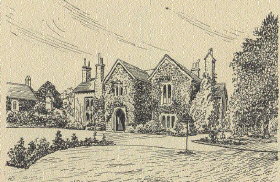
The Prebendal House and Chapel, from a drawing by M Forsyth published in 1938
What is a Prebend, a Prebendal Church and a Rectory?
The History of Thame Prebend
The Full List of Thame Prebendaries
There was a community of prebendal monks at Thame, recorded first in the thirteenth century, which along with the prebendary himself probably accounts for the name Priestend.
Part of the endowment of land given to the prebend by the Bishop of Lincoln is thought to have become the manor of Priestend.
The last prebendary relinquished his lands and rights at Thame into secular hands in 1547, following the Reformation.
No Longer belonging to Lincoln Cathedral, the prebend lost of a lot of its land but remained a valuable possession. It became known as the Rectory of Thame.
The History of Thame Rectory and Advowson
The Prebendal House remained in ruins until 1836. when a wealthy local man, Charles Stone, bought it and began to renovate it, making it his own residence.
In the 1841 census the inhabitants of the Prebendal House are listed as Mr Charles Stone, aged 45 and Ann Parker, aged 20, presumably his servant.
In 1845 the Prebendal House was sold to Mr John Stone, reputedly for £2,400.
Mr John Stone, a magistrate, is listed at the Prebendal House in trade directories until the year 1854, whilst the 1861 census records that by that year a Mr James Bancks, his family and their servants were living at the Prebendal House. It is possible that Mr Bancks built the Prebendal Lodge which hides the house from view today.
By 1882 the Prebendal House was the home of William Lightfoot, and the 1891 census reveals a widow Lightfoot at the Prebendal, with her two sons William T Lightfoot, a surgeon, and Edward Lynch Lightfoot, a solicitor, who became part of a firm of solicitors known as Lightfoot and Lowndes, very prominent in Thame in the twentieth century.
Kelly's Directory in 1915 and 1920 reports that the resident at the Prebendal was Lt-Colonel Harman J Grisewood.
In 1912 and 1913 Colonel Grisewood organised public Roman Catholic services within the ancient chapel within the grounds of the Prebendal House, where the Roman Catholic mass had presumably not been heard since 1547, a gap of 365 years.
There was at this time a resident Roman Catholic priest, Father Randolph Traill, who lived in the Prebendal Lodge in 1920. In 1922 Thame's Roman Catholic community opened St Joseph's Church in Brook Lane.
Colonel Grisewood had a son, Harman Joseph Gerard Grisewood CBE, who had a long and distinguished career in the BBC. His obituary appeared in the Guardian on 11th January 1997, written by Fiona MacCarthy. It contains an astonishing reference to Thame.
"Harman had inherited his father's infectious charm. He was a wonderful raconteur and even better listener, fascinated by the detail of people’s daily lives. In his autobiography, One Thing at a Time (1968), he gives a good account of his Catholic childhood in a rambling 13th century Oxfordshire house at Thame, much of it in ruin. It had its own chapel and resident priest, Father Traill. Grisewood used to tell a terrifying story of the day he and his brother, on an outing with their nanny and a nursemaid, were stoned in their prams by villagers as they approached the Anglican church. He was a tiny man with a considerable presence. As a child he had voiced an ambition to be Pope."
This astonishing event, if it is related corretly would have taken place in 1907 or 1908.
The Grisewoods had left the Prebendal by 1924, and there were a number of other owners, before the present owners, who are rightly proud of their historical home.
Tracking the history of the Prebendal House back through the centuries, now a prestigious private residence, formerly the scene of a Roman Catholic revival, a Victorian rescue of a ruined ancient house and chapel, nearly two centuries of neglect, the home of the prebendaries of Thame for four centuries and before that, who knows.
The site of the Prebendal House is very close to the original heart of the Anglo Saxon settlement at Thame, and it is almost certain that some sort of building or enclosure would have existed on this site before the twelfth century.
The grounds of the Prebendal House were originally surrounded on three sides by a man-made moat, and on the fourth side by the river Thame. The moat could well have been a part of the original Anglo Saxon defences or an enclosure boundary.
Standing today on the Crendon Bridge, with the River Thame snaking away to either side, the Prebendal grounds lying along the river bank and St Mary's Church rising up in the background, you are at the ancient heart of Thame.
The Prebendal at Thame features in one of several local myths about underground tunnels, believed to have been constructed by medieval clerics.
'Strange Thame' and the Prebendal Tunnel
In this case the supposed tunnel runs from the Prebendal House to Notley Abbey, a former Augustian Abbey on the banks of the river Thame just east of Long Crendon.
Needless to say, if such a tunnel were found to have really existed, it would be an archaeological find, and an engineering feat, of great proportions.